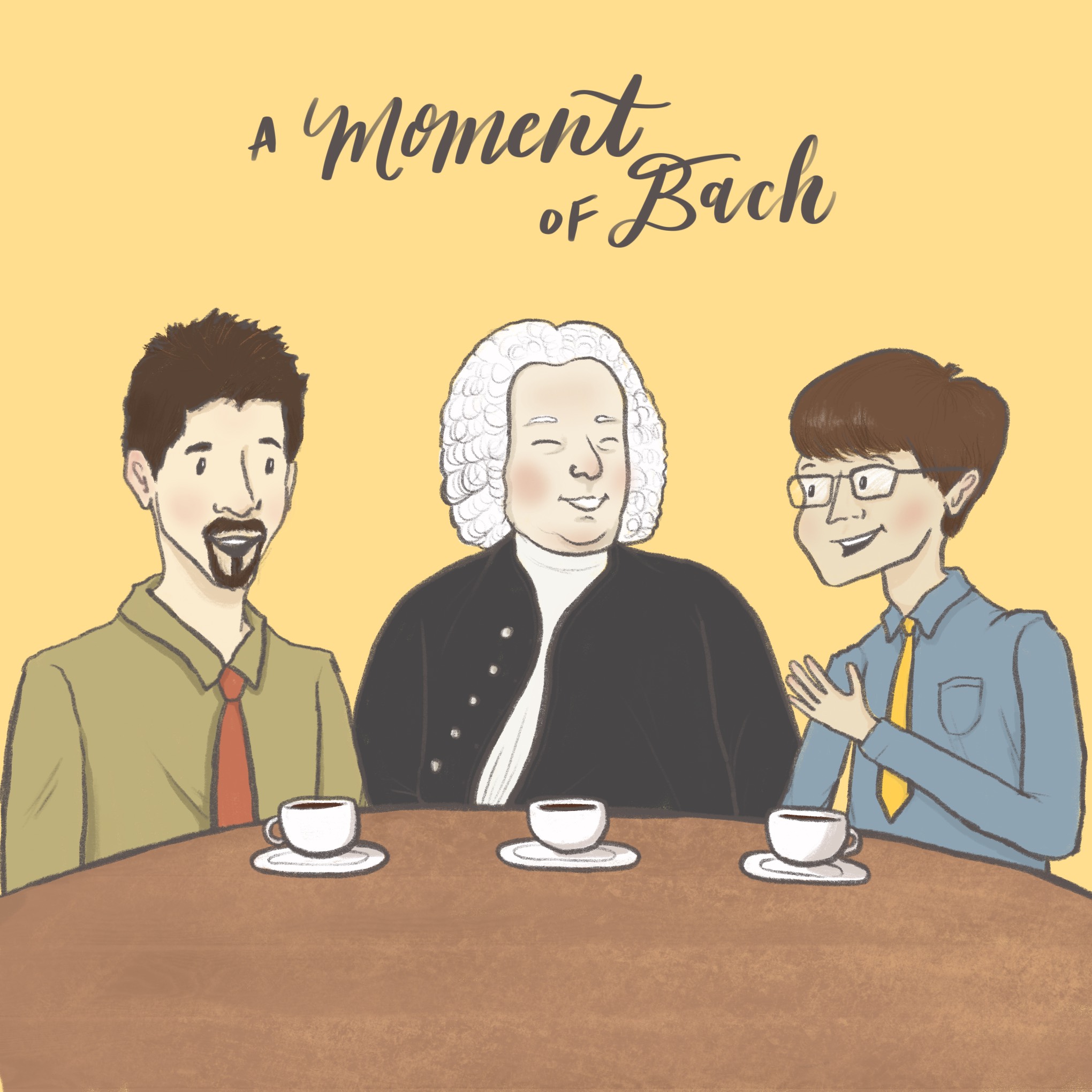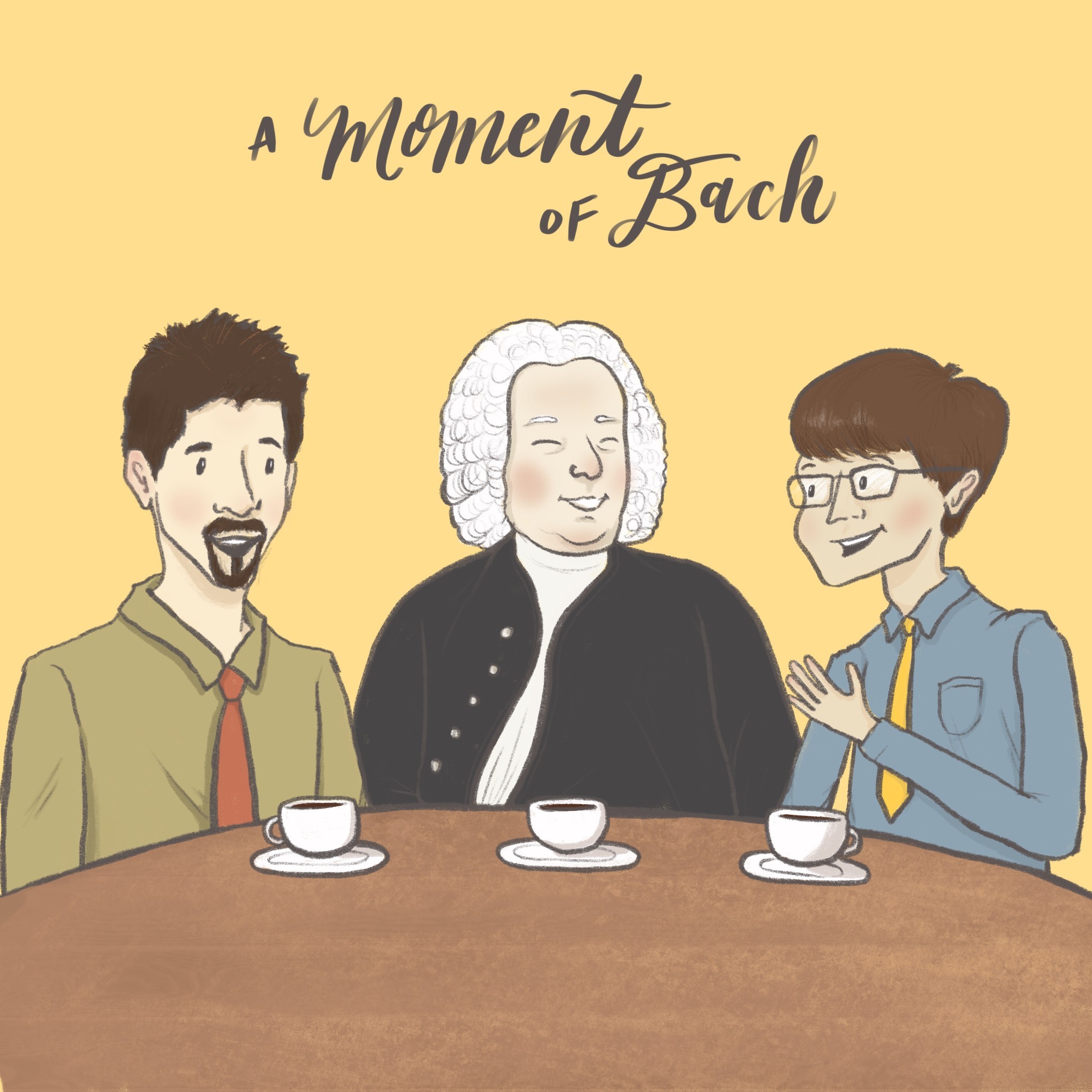
244.4K
Downloads
176
Episodes
Welcome to A Moment of Bach, where we take our favorite moments from J. S Bach's vast output—just a minute's worth or even a few seconds—and show you why we think they are remarkable. Join hosts Alex Guebert and Christian Guebert for weekly moments! Check wherever podcasts are available and subscribe for upcoming episodes. Our recording samples are provided by the Netherlands Bach Society. Their monumental All of Bach project (to perform and record all of the works of J. S. Bach) serves as source material for our episodes. https://www.bachvereniging.nl/en https://www.bachvereniging.nl/en/allofbach Artwork by Sydney LaCom
Episodes

Monday Apr 24, 2023
Prelude no. 15 in G major (Well-Tempered Clavier Book 2)
Monday Apr 24, 2023
Monday Apr 24, 2023
Today we talk about clever twists, whether in music or in stories, and how these twists can be delightful in their subversion of our expectations -- when done well. In this less-than-famous little prelude from the famous compilation The Well-Tempered Clavier, Bach uses deceptive cadences to add flavor to the music without sacrificing the form, in such a way that the music feels inevitable.
Thanks as always to Netherlands Bach Society for the use of their excellent recordings as our musical examples!
Excerpt from Mozart's Symphony no. 40 in G minor, mvt.4, from Das Orchester Tsumugi, Fukuoka, Japan; public domain recording (Creative Commons Attribution 3.0)

Monday Apr 17, 2023
Cello Suite no. 6: Allemande
Monday Apr 17, 2023
Monday Apr 17, 2023
Sergey Malov, who plays all six cello suites on his violoncello da spalla (shoulder cello), gives us the inspiration to look at the suites in a new way. They "transcend" the instrument itself, as by the last one, it's clear that you are meant to be using an instrument with a higher fifth string. The allemande of the sixth suite also transcends its simple dance roots and flows out of its bounds.
Thanks to listener H.G. for the suggestion of the Allemande moment.
https://www.youtube.com/watch?v=wbH3JYfRjOQ&t=265s

Monday Apr 10, 2023
Bleib bei uns (BWV 6): opening chorus
Monday Apr 10, 2023
Monday Apr 10, 2023
Stay with us, for night is falling.
On this Easter Monday, we return to Bach's Easter Monday cantata Bleib bei uns ("Stay with us"). We talked about this cantata in Season 1, but here we can't help but return to the captivating opening chorus, which reminds us of the closing choruses of the St. Matthew and St. John Passions. Ever the pictorial composer, Bach uses repeated notes to paint the picture of God's steadfastness -- how He stays with us. The middle section brings us into a lively double (or is it triple...?) fugue, culminating in Alex's favorite moment, a quadruple-octave blast from the choir.
Bleib bei uns performed by the Netherlands Bach Society, Jos van Veldhoven, conductor.
SOUTHERN CALIFORNIA LISTENERS: check out Alex's concert THIS SUNDAY in Orange, CA which features this very cantata, Bleib bei uns, as well as some other hymn and liturgy arrangements, all in the musical context of an evening prayer service. Details here.

Monday Apr 03, 2023
St. Matthew Passion: three transitions
Monday Apr 03, 2023
Monday Apr 03, 2023
Sometimes the most meaningful moment is the in-between. After learning that one of them would betray Jesus, the disciples (Choir 1 in the St. Matthew Passion) all clamor to exclaim: "Lord, is it me?"
We pause. Christ doesn't answer immediately. We know the answer. Both choirs admit: "It is me whose sin binds you." This chorale response which follows the bible passage shows that the answer is more than just Judas.
These pauses between are often profound, introspective, or even crushingly sad. The second moment in this episode is one of contrite pleading after the Erbarme Dich aria and before a penitent chorale. The third is the stark silence of the moment after Christ's death.
For Bach the expert storyteller, these transitions have an essential power of their own.
Thank you listener Dave for inspiring the concept for this episode, and suggesting the second moment.
Special thanks to the Netherlands Bach Society for the use of the audio examples and links to video examples.

Monday Mar 27, 2023
Ich elender Mensch (BWV 48)
Monday Mar 27, 2023
Monday Mar 27, 2023

Monday Mar 20, 2023
Nun komm, der Heiden Heiland (BWV 61) chorale: ”Amen, amen!”
Monday Mar 20, 2023
Monday Mar 20, 2023
A 45-second masterpiece: the ecstatic joy bursts forth from this hurried chorale, begging Jesus, the Crown of Joy, to return. Amen, amen!
The urgency becomes part of the musical structure; Bach doesn't even have time for the whole hymn stanza as he sets the mystical text from only the last bit of the last stanza of Philipp Nicolai's hymn Wie schön leuchtet der Morgenstern (O Morning Star, How Fair and Bright). A brilliant high note and descent of the last phrase reminds us of "Joy to the World." And yet, while the first Advent is shown in the descending notes, the violins don't tarry as they carry us up and up to an unusually high G.
"Amen, amen!" chorale in BWV 61, Netherlands Bach Society
Text translation and commentary used by the Netherlands Bach Society and referenced in this episode are by bachcantatatexts.org (BWV 61) by Daniel R. Melamed and Michael Marissen
Bachstiftung (J. S. Bach Foundation) video recording of a particularly fast performance

Monday Mar 13, 2023
The Art of Fugue (BWV 1080): Final (unfinished) fugue
Monday Mar 13, 2023
Monday Mar 13, 2023
The Requiem by Mozart, Schubert's unfinished symphony, the incomplete Beach Boys album Smile... ever since the biblical story of the Tower of Babel we humans have been fascinated by the idea of an unfinished work of art. The reconstruction by Netherlands Bach Society of the ending of Bach's Art of Fugue gets us very close to what the master himself might have done, had his pen not stopped on the page. Perhaps the idea of incompleteness itself is a comforting thought -- even Bach, who left us so much high-quality art, never completed this culminating masterwork... is anyone's life's work every truly complete? Certainly Bach's legacy lives on despite this omission. Even so, we can't help but wonder what his ending to this piece would have sounded like.

Monday Mar 06, 2023
The Art of Fugue (BWV 1080): Contrapunctus I
Monday Mar 06, 2023
Monday Mar 06, 2023
After writing the Goldberg Variations, what was left to write?
Welcome back to A Moment of Bach! We embark on our third season by celebrating the recent release of the Netherlands Bach Society's "Die Kunst der Fuge" -- a brilliant new arrangement of the towering masterwork. The expressive and unusual instrumentation makes this recording unlike any other.
Die Kunst der Fuge BWV 1080 by the Netherlands Bach Society, arr. Shunske Sato
PATREON -- a new opportunity to donate to A Moment of Bach -- always optional, always appreciated!
Stefano Greco lecture including a new theory on the order of the parts of the Art of Fugue

Saturday Oct 22, 2022
BONUS: Jim Meredith, Sonos Handbell Ensemble director (BACHTOBERFEST bonus 2 of 2)
Saturday Oct 22, 2022
Saturday Oct 22, 2022
One more BACHTOBERFEST festivity: a conversation with a wonderful guest.
Does Bach's music work on modern instruments which were designed after his time? Our guest, conductor and composer James Meredith is the long-time Artistic Director of the top-tier Sonos Handbell Ensemble. Jim talks about his love of Bach, his avenue toward handbells as an instrument of high-level performance, and his own Bach transcriptions for the instrument. Before the interview, we answer a question about the “Little Fugue” in G major.
“Now Hear This” by Scott Yoo on PBS
Christian’s upcoming BWV 61 Cantata performance: Sunday, Dec. 11 at 3:00 here (free)

Monday Oct 10, 2022
BONUS: Blooper reel Season 2 (BACHTOBERFEST bonus 1 of 2)
Monday Oct 10, 2022
Monday Oct 10, 2022
As promised, here are the silly bloopers that we both collected throughout this year! Stay tuned for one more bonus episode: the interview about Bach and the handbell ensemble with James Meredith, artistic director of Sonos.
